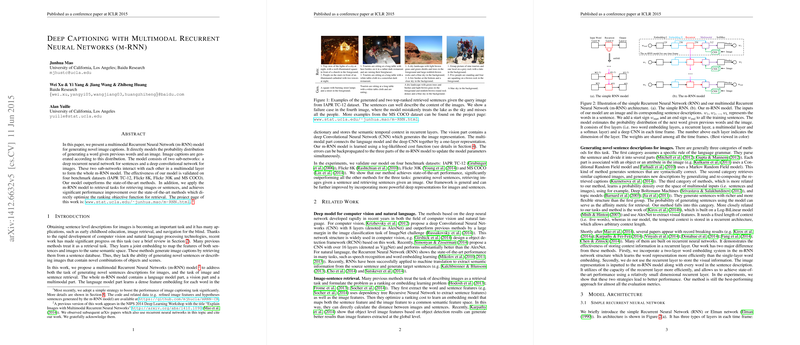Deep Captioning with Multimodal Recurrent Neural Networks (m-RNN): A Synthesis
The paper "Deep Captioning with Multimodal Recurrent Neural Networks (m-RNN)" by Junhua Mao et al. provides a robust exploration of generating image captions using a cohesive architecture that integrates visual and linguistic information. The m-RNN model introduces a framework which demonstrates superior performance across several benchmarks for both generative and retrieval tasks, setting a high standard in the domain of vision-language integration.
Model Architecture
At the core of the paper is the m-RNN model, which strategically combines a deep Convolutional Neural Network (CNN) for image representation with a Recurrent Neural Network (RNN) for sequential LLMing. These two subnetworks interface through a multimodal layer, allowing for the efficient blending of visual and linguistic features.
Key components include:
- Word Embedding System: Two sequential word embedding layers that encode words into dense vectors, capturing syntactic and semantic nuances.
- Recurrent Layer: A 256-dimensional recurrent layer designed to maintain temporal dependencies in linguistic data without escalating computational demands.
- Multimodal Layer: This layer merges representations from the word embedding layers, the recurrent layer, and the CNN, culminating in a softmax layer to generate the probability distribution of the next word in the sequence.
Training and Evaluation
The model is trained using a log-likelihood cost function, optimizing the probability of generating target sentences conditioned on corresponding images. This is achieved by backpropagating the cost function's gradient through both the visual and language components of the network, hence fine-tuning both representations in a unified manner.
The efficacy of the m-RNN model was validated across four key benchmark datasets: IAPR TC-12, Flickr 8K, Flickr 30K, and MS COCO. The performance metrics included BLEU scores and recall rates (R@K) for both sentence generation and retrieval tasks. Notably, the model outperformed prior state-of-the-art methods significantly, particularly in terms of BLEU scores, which emphasize generating coherent and contextually appropriate sentences.
Results
Sentence Generation
- On IAPR TC-12, the m-RNN model achieved higher BLEU scores compared to models such as MLBLB-AlexNet and MLBLF-AlexNet.
- Evaluation on Flickr8K dataset demonstrated that m-RNN surpasses competing approaches like Deep Fragment Embedding (DeepFE) and Structured Deep Embedding (SDE) using comparable image features.
Retrieval Tasks
- In sentence retrieval tasks (Image to Text) and image retrieval tasks (Text to Image) across multiple datasets, m-RNN exhibited superior rank-based retrieval performance, notably improving R@K scores and achieving lower median ranks.
- On MS COCO, m-RNN with VggNet representations achieved the highest results in both sentence and image retrieval tasks, setting a new benchmark.
Theoretical and Practical Implications
The paper makes several salient contributions:
- Enhanced Integration of Visual and Linguistic Data: By directly incorporating image features into the multimodal layer rather than diluting them across recurrent layers, the m-RNN maximizes the synergy between vision and language.
- Efficiency in Representation Learning: The two-layer word embedding system proves more effective than simplistic one-layer embeddings, leading to richer semantic representations and improved LLMing.
Future Prospects
The m-RNN framework opens several avenues for future research:
- End-to-End Learning with Larger Datasets: With the expansion of datasets like the full MS COCO, there exists the potential to leverage end-to-end training of both vision and language components, potentially refining visual feature extraction.
- Incorporation of Advanced Image Representations: Integration of object detection systems such as RCNN could enhance the model's ability to parse complex scenes.
- Exploring Alternative RNN Architectures: Adoption of architectures like LSTM or GRU could mitigate issues like the exploding gradient problem and further enhance performance.
In conclusion, the m-RNN model represents a significant advancement in the field of image captioning, achieving notable improvements in both generative and retrieval metrics across several benchmark datasets. The findings and methods proposed in this paper lay a robust foundation for future explorations into multimodal learning, bridging the domains of computer vision and natural language processing more seamlessly.
